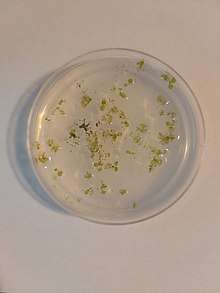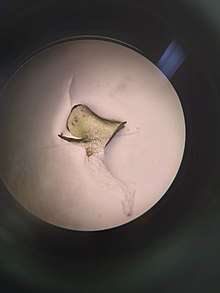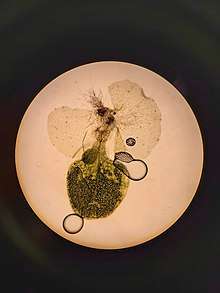Ceratopteris richardii
Ceratopteris richardii is a fern species belonging to the genus Ceratopteris, one of only two genera of the subfamily Parkerioideae of the family Pteridaceae.[1] It is one of several genera of ferns adapted to an aquatic existence. C. richardii was previously regarded as being part of the species Ceratopteris thalictroides.
| Triangle water fern | |
|---|---|
 | |
| "C-Fern" growing on agar media in cell culture dish | |
| Scientific classification | |
| Kingdom: | Plantae |
| Clade: | Tracheophytes |
| Class: | Polypodiopsida |
| Order: | Polypodiales |
| Family: | Pteridaceae |
| Genus: | Ceratopteris |
| Species: | C. richardii |
| Binomial name | |
| Ceratopteris richardii | |
"C-Fern"
This particular species is of special scientific interest because a patented strain, called "C-Fern", was developed as a scientific aid and teaching tool in biology in 1995.[2] The use of "C-Fern" is facilitated by the fact that it grows readily in a cell-culture dish on agar media, reaching sexual maturity within 2–3 weeks of spore inoculation, with motile sperm cells being visible at this time. Over the course of about 6 weeks germination, sex determination and development of gametophytes, fertilization, embryogenesis, organogenesis, and sporophyte growth can all be observed, allowing an incredibly comprehensive study of the life cycle of homosporous ferns in a relatively short time period.[3] In addition, due to the small size of the plant many specimens can be observed growing simultaneously, allowing for larger sample sizes in research studies. Following the culture of "C-Fern" in dishes it can be transplanted to a dirt substrate, where it can be further allowed to grow and future generations can be used for subsequent studies.
Monilophytes are generally studied far less than other groups of plants and a full genome sequence is not yet available, however due to the development of "C-Fern" research into fern biology has been more prevalent and C. richardii has been used as a model organism to study vascular plant cell walls, alternation of generations (and associated mutations), genetics, population dynamics, and the effects of mitotic disrupter herbicides, among other topics.[4][5][6] Despite being genetically identical the inoculated spores can give rise to both hermaphrodites and male gametophytes, depending on the secretion of Antheridiogen; this phenomenon has been used to study plant pheromones and the cascade of events that leads to epigenetic changes in ferns.[7] The ability to switch from bisexual to all male spores may provide an evolutionary advantage by promoting outbreeding.[8]
The use of C. richardii in genetic research studies has been valuable to understanding fern and plant evolution as a whole, and in 2019 "C-fern" became the first homosporous fern to have its genome partially assembled, thus acting as a reference genome to which other ferns can be compared.[9]
C. richardii spores germinated in space in 1999 on shuttle mission STS-93, making them one of the few plants to be grown in space.[10]


References
- PPG I (2016), "A community-derived classification for extant lycophytes and ferns", Journal of Systematics and Evolution, 54 (6): 563–603, doi:10.1111/jse.12229
- C-fern official site
- Renzaglia, Karen Sue; Warne, Thomas R. (May 1995). "Ceratopteris: An Ideal Model System for Teaching Plant Biology". International Journal of Plant Sciences. 156 (3): 385–392. doi:10.1086/297260. ISSN 1058-5893.
- Spiro, Mark D.; Knisely, Karin I. (March 2008). Sundberg, Marshall (ed.). "Alternation of Generations and Experimental Design: A Guided-Inquiry Lab Exploring the Nature of the her1 Developmental Mutant of Ceratopteris richardii (C-Fern)". CBE—Life Sciences Education. 7 (1): 82–88. doi:10.1187/cbe.07-82-88. ISSN 1931-7913. PMID 18316811.
- Hoffman, J. C.; Vaughn, K. C. (March 1996). "Spline and flagellar microtubules are resistant to mitotic disrupter herbicides". Protoplasma. 192 (1–2): 57–69. doi:10.1007/BF01273245. ISSN 0033-183X. S2CID 19844471.
- Leroux, Olivier; Eeckhout, Sharon; Viane, Ronald L. L.; Popper, Zoë A. (2013). "Ceratopteris richardii (C-fern): a model for investigating adaptive modification of vascular plant cell walls". Frontiers in Plant Science. 4: 367. doi:10.3389/fpls.2013.00367. ISSN 1664-462X. PMC 3779834. PMID 24065974.
- Atallah, Nadia M.; Vitek, Olga; Gaiti, Federico; Tanurdzic, Milos; Banks, Jo Ann (July 2018). "Sex Determination in Ceratopteris richardii Is Accompanied by Transcriptome Changes That Drive Epigenetic Reprogramming of the Young Gametophyte". G3: Genes | Genomes | Genetics. 8 (7): 2205–2214. doi:10.1534/g3.118.200292. ISSN 2160-1836. PMC 6027899. PMID 29720393.
- Timothy Walker, Plants: A Very Short Introduction. Oxford University Press, 2012. p. 49
- Marchant, D. Blaine; Sessa, Emily B.; Wolf, Paul G.; Heo, Kweon; Barbazuk, W. Brad; Soltis, Pamela S.; Soltis, Douglas E. (December 2019). "The C-Fern (Ceratopteris richardii) genome: insights into plant genome evolution with the first partial homosporous fern genome assembly". Scientific Reports. 9 (1): 18181. Bibcode:2019NatSR...918181M. doi:10.1038/s41598-019-53968-8. ISSN 2045-2322. PMC 6890710. PMID 31796775.
- Salmi, ML; Roux, SJ (2008). "Gene expression changes induced by space flight in single-cells of the fern Ceratopteris richardii". Planta. 229 (1): 151–9. doi:10.1007/s00425-008-0817-y. PMID 18807069. S2CID 30624362.
